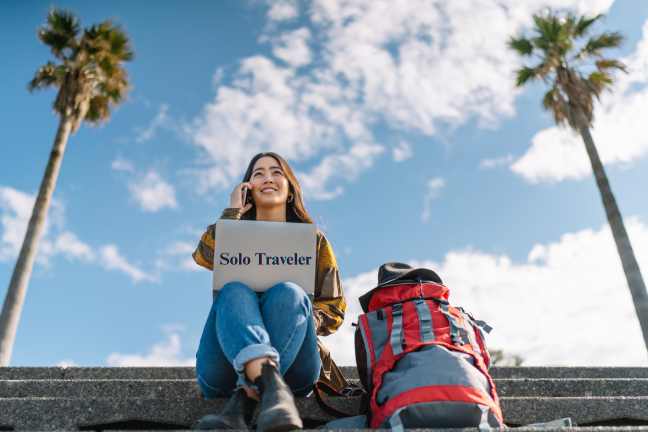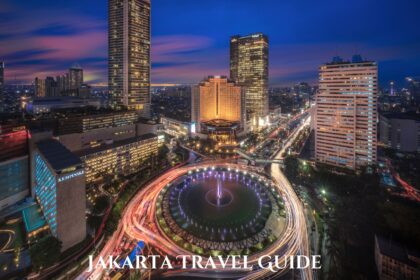Solo travel has a way of making you feel invincible. After successfully navigating foreign airports, deciphering train schedules in languages you don’t speak, and finding your way through maze-like medinas, you start to believe you can handle anything. This confidence is one of solo travel’s greatest gifts – it transforms you from someone who needs guidance into someone who creates their own adventures.
But confidence without awareness is just another word for recklessness, and I learned this lesson the hard way across multiple continents and several genuinely dangerous situations that could have ended very differently. The same independence and adventurous spirit that makes solo travel so rewarding can also lead you into situations where being alone becomes a serious liability rather than an asset.
This isn’t meant to scare anyone away from solo travel – some of my most transformative life experiences happened when I was traveling alone. But it is a reality check about the specific vulnerabilities that come with solo exploration and the safety mistakes that can turn an adventure into a nightmare. Here are the hard-learned lessons from moments when my solo travel confidence nearly got me into serious trouble.
READ ALSO: How to Choose Solo Travel Destinations – Comprehensive Guide
The False Security of Crowded Places: When Tourist Areas Become Danger Zones

The Setup: I was spending a few days in Rio de Janeiro, staying in the Copacabana area and feeling completely safe during the day. The beaches were crowded with families, vendors were everywhere, and the atmosphere felt festive and welcoming. As a solo traveler, I felt more secure in busy, tourist-heavy areas.
The Mistake: On my third evening, I decided to walk along the beach after sunset to get some photos of the city lights. The area was still relatively busy, and I reasoned that being in such a famous, well-patrolled tourist zone meant I was safe even after dark.
The Reality Check: What I didn’t understand was that the dynamics of public spaces change dramatically after dark, even in tourist areas. The families and legitimate vendors disappeared, replaced by different groups with different intentions. The very visibility that made me feel safe during the day made me a clear target at night.
The Close Call: Three men approached me asking for directions, which seemed innocent enough. When I pulled out my phone to help them navigate, they surrounded me and made it clear that this wasn’t actually about directions. The phone, my camera, and my wallet were what they wanted, and my solo status made their job much easier.
The Escape: I was fortunate that a group of local surfers was nearby and the situation de-escalated quickly when they intervened. But I realized how completely I had misread the safety dynamics of the area and how my solo status had made me an easy target.
The Lesson: Crowded doesn’t always mean safe, and tourist areas can be prime hunting grounds for people who target visitors. The safety calculus changes significantly between day and night, and between solo and group travel.
The Prevention Strategy: Research the specific safety dynamics of tourist areas at different times of day. What’s safe for families at 2 PM might be dangerous for solo travelers at 10 PM. Local tourism offices and hostel staff are good sources for this kind of nuanced safety information.
The Communication Void: When No One Knows Where You Are
The Setup: I was backpacking through remote areas of northern Vietnam, following a route I’d pieced together from various blog posts and guidebooks. I wanted to experience the “real” Vietnam away from tourist trails, and I was proud of having planned such an authentic, off-the-beaten-path adventure.
The Mistake: In my enthusiasm for spontaneous exploration, I had developed a habit of changing my plans frequently without telling anyone. I would decide to take a different route, stay an extra day somewhere interesting, or skip planned destinations based on recommendations from locals I met along the way.
The Isolation: After taking a recommendation to visit a remote village accessible only by motorbike, I found myself in an area with no cell phone coverage, no internet, and no way to communicate with the outside world. I had told no one about this detour, and my last check-in with friends was from a town three days away.
The Problem: When my motorbike broke down in the middle of nowhere, I realized the full implications of my communication failure. Not only was I stranded in a place where very few people spoke English, but literally no one in the world knew where I was or when to expect me to surface again.
The Reality: I spent two days in the village waiting for someone to fix my motorbike, completely cut off from any way to get help or let anyone know I was safe. If something serious had happened – an accident, a medical emergency, or worse – no one would have known where to start looking for me.
The Lesson: Flexibility and spontaneity are wonderful aspects of solo travel, but someone should always know your general location and expected timeline. This isn’t about checking in daily, but about maintaining a basic safety net that can help if things go seriously wrong.
The System: I now use a simple system of checking in with a designated person every few days with my approximate location and next planned destination. I also share my general itinerary with someone reliable who knows to be concerned if I don’t check in within a reasonable timeframe.
The Transportation Gamble: When Cheap Rides Become Dangerous Situations
The Setup: I was in Guatemala trying to get from Antigua to a remote village to visit some Mayan ruins. The official bus route was expensive and took two days with multiple connections, while local transport options were much cheaper and more direct.
The Tempting Offer: A man at the bus station offered me a ride in his private vehicle for half the price of the official transport. He spoke good English, seemed friendly, and claimed he was going to the same area to visit family. It felt like a lucky coincidence and a great way to save money while getting local insights.
The Red Flags I Ignored: He was unusually insistent that I ride with him rather than take official transport, he wanted payment upfront, and he discouraged me from telling anyone about the ride arrangement. At the time, I rationalized these as cultural differences or his eagerness to help a solo traveler.
The Danger Zone: About an hour into the journey, he picked up two other men without asking me. The car was now full of strangers, we were on remote mountain roads, and I had no way to communicate our location to anyone. The dynamic in the car changed completely, and I realized I had put myself in a potentially very dangerous situation.
The Turning Point: When they started discussing route changes in Spanish (which they didn’t know I partially understood), I knew I needed to get out of the car immediately. At the next gas station, I insisted on getting out and refused to continue the journey, despite having paid in advance.
The Expensive Lesson: I ended up paying triple the original bus fare for emergency transport back to safety, plus the money I’d lost on the original ride. More importantly, I realized how my desire to save money and have “authentic” local experiences had overridden basic safety judgment.
The Prevention Principles:
- Never get into unofficial transport alone, especially as a solo traveler
- Always use official, licensed transport services for longer journeys
- Trust your instincts when something feels wrong, even if you can’t articulate why
- The money you save on unofficial transport isn’t worth the safety risks
The Accommodation Isolation: When Saving Money Means Losing Safety
The Setup: I was traveling through rural Romania and found an incredibly cheap guesthouse advertised online. The price was too good to pass up, and the remote location seemed perfect for experiencing authentic rural life away from tourist crowds.
The Warning Signs: The guesthouse was several kilometers from the nearest village, accessible only by a dirt road, and I would be the only guest. The owner communicated only through broken English emails and seemed oddly insistent that I not book through official platforms.
The Rationalization: I convinced myself that the isolation was exactly what I was looking for – a peaceful retreat where I could disconnect from the world and enjoy rural tranquility. The low price seemed like a bonus for choosing adventure over comfort.
The Reality: When I arrived, the “guesthouse” was essentially a small house in the middle of nowhere with no neighbors, no cell phone coverage, and no transportation back to town except the owner’s vehicle. The owner was friendly enough, but I realized I was completely dependent on him for everything – food, transportation, even basic safety.
The Vulnerability: On my second night, I heard the owner drinking heavily and arguing loudly on the phone. I realized that if his mood changed or if he had bad intentions, I was completely trapped with no way to get help or even communicate with the outside world.
The Escape Plan: I spent a sleepless night planning how to leave safely and managed to convince him to drive me back to town the next morning by claiming a family emergency. I never felt comfortable enough to sleep soundly during my stay.
The Lesson: Isolation can be wonderful for peace and reflection, but as a solo traveler, you need to maintain access to help and communication. Complete isolation becomes a safety risk when you have no backup support system.
The Balance: Seek peaceful, less touristy accommodations, but ensure they have basic safety features: cell phone coverage, proximity to other people, multiple ways to leave if needed, and transparent booking processes.
The Cultural Misunderstanding: When Ignorance Becomes Dangerous
The Setup: I was exploring rural areas of Pakistan, fascinated by the incredible hospitality and eager to experience authentic local culture. I had read about the tradition of hospitality to guests and felt confident that my respectful attitude and genuine interest in local customs would be welcomed everywhere.
The Mistake: I didn’t adequately research the specific cultural and religious sensitivities of the regions I was visiting. I assumed that basic politeness and respect would be sufficient to navigate any cultural differences, and I was overconfident in my ability to read social situations across cultural boundaries.
The Incident: While visiting a small village, I inadvertently violated several local customs simultaneously – I photographed people without permission, entered a religious area at an inappropriate time, and interacted with local women in ways that were considered inappropriate by community standards.
The Escalation: What started as cultural misunderstanding quickly escalated to genuine anger from some community members. As a solo foreign traveler who couldn’t speak the local language and didn’t understand the severity of what I had done, I found myself in a situation that was becoming genuinely threatening.
The Resolution: Fortunately, an English-speaking local intervened and helped explain both my innocent intentions and the community’s concerns. The situation was resolved peacefully, but it could have gone very differently if I had been in a less tolerant community or if no mediator had been available.
The Lesson: Cultural sensitivity isn’t just about being polite – in some contexts, cultural mistakes can create genuine safety risks. As a solo traveler, you don’t have travel companions to help navigate misunderstandings or provide witnesses to your innocent intentions.
The Preparation: Research specific cultural and religious practices for your destinations, especially in conservative or traditional communities. Understand which behaviors might be offensive or dangerous, and err on the side of caution when in doubt.
The Technology Dependence: When Your Digital Safety Net Fails
The Setup: I had become completely dependent on my smartphone for navigation, communication, translation, and emergency contacts. My travel apps, GPS, and digital copies of important documents were my primary safety tools, and I felt confident that technology would help me handle any situation.
The Failure Point: During a solo hiking trip in the Scottish Highlands, my phone died completely – not just a dead battery, but a complete hardware failure that made it unusable. Suddenly, I had no map, no way to call for help, no emergency contacts, and no access to any of the digital safety tools I relied on.
The Consequences: I was lost on a remote mountain trail with weather conditions deteriorating rapidly. Without GPS, I couldn’t find the path back to the main trail, and without communication, I couldn’t call for help. I had no physical backup for any of my digital safety tools.
The Survival Mode: I spent a terrifying night lost in the mountains before finally finding my way back to a marked trail the next morning. The experience taught me how completely vulnerable I had become to technology failures, especially when traveling alone.
The Backup Systems: Since then, I always carry physical backups for essential digital tools: paper maps, written emergency contacts, photocopies of documents, and a basic emergency kit that doesn’t require technology to use.
The Lesson: Technology is an incredible travel tool, but it should supplement, not replace, basic safety preparations. Solo travelers especially need redundant systems because there’s no one else to rely on when primary systems fail.
The Overconfidence Evolution: How Success Breeds Dangerous Assumptions
The Pattern Recognition: After months of successful solo travel, I started to believe I could handle any situation. Each positive experience reinforced my confidence that I was street-smart, culturally aware, and capable of managing any challenge that arose.
The Assumption Trap: This confidence led me to take increasingly risky chances – walking alone in areas I hadn’t researched, trusting strangers more quickly, and dismissing safety warnings as overcautious advice meant for less experienced travelers.
The Reality Check: The more confident I became, the more likely I was to ignore warning signs that I would have heeded as a nervous beginner. I started trusting my “instincts” in situations where I actually had no relevant experience or cultural knowledge to guide me.
The Dangerous Cycle: Each time I took a risk and nothing bad happened, it reinforced my belief that I was invulnerable. I didn’t realize that many of my “successful” risk-taking episodes were actually just lucky breaks rather than good judgment.
The Recalibration: It took several genuinely scary situations to make me realize that experience should make you more cautious, not less. The more you understand about potential dangers, the more seriously you should take safety precautions, not the less.
Building Sustainable Solo Travel Safety Habits
After learning these lessons the hard way, I developed a more mature approach to solo travel safety:
The Information Network: Always maintain multiple ways for people to find you if needed. Share general itineraries, check in regularly, and have systems in place for when plans change unexpectedly.
The Redundancy Principle: Have backup plans for your backup plans. Multiple forms of communication, payment, transportation, and accommodation options prevent single points of failure from becoming dangerous situations.
The Local Intelligence: Invest time in understanding local safety dynamics from reliable sources. Tourism offices, quality accommodations, and other travelers can provide current, specific safety information that general guidebooks miss.
The Instinct Development: Learn to distinguish between normal travel anxiety and genuine danger signals. Sometimes feeling uncomfortable is your subconscious picking up on real problems that your conscious mind hasn’t recognized yet.
The Humble Confidence: Confidence is essential for solo travel, but it should be paired with humility about what you don’t know. The most dangerous solo travelers are those who think they know everything about places they’ve never been.
The Balance Between Safety and Adventure
The goal isn’t to eliminate all risks from solo travel – that would eliminate most of what makes it rewarding. The goal is to take calculated risks based on good information rather than unnecessary risks based on overconfidence or ignorance.
Some of my most meaningful travel experiences involved stepping outside my comfort zone and trusting strangers who turned out to be genuinely helpful and kind. The key is developing the judgment to distinguish between reasonable risks that lead to great experiences and unnecessary risks that lead to dangerous situations.
Solo travel safety isn’t about being paranoid or suspicious of everyone you meet. It’s about maintaining awareness of your vulnerabilities as a solo traveler and taking reasonable precautions to ensure that your independence remains an asset rather than becoming a liability.
The best solo travelers I know are confident but cautious, adventurous but prepared, and trusting but not naive. They understand that being alone in unfamiliar places requires a higher level of safety awareness, and they’ve developed systems and habits that allow them to travel boldly while staying safe.
Every solo traveler will face situations that test their judgment and their luck. The difference between a great story and a genuine disaster often comes down to preparation, awareness, and the wisdom to know when adventure is worth the risk and when caution is the better choice.
In another related article, Solo Travel Guide to Spain






